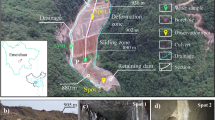Consolidated quick direct shear tests were conducted on bentonite and mixed bentonitekaolin soils with different concentrations of sodium chloride solution. The physical mechanism of the pore fluid concentration effect was explained at the micro level on the basis of micro forces among particles. The test results indicated that the shear strength of bentonite and bentonite-kaolin noticeably varied with increase in sodium chloride solution concentration, especially under high vertical stress. The friction angle increased with the pore fluid concentration, but the cohesion decreased. With increase in pore fluid concentration, the electric double-layer repulsion among soil particles decreased, thereby increasing the effective contact stress at the mineral-mineral contact and leading to increased consolidation settlement and a lower water content under vertical stress. This means a larger shearing resistance at the mineral-mineral contact point and a thinner absorbed water layer at the mineral-water-mineral contact point, leading to a greater friction angle and a lower cohesion.
Similar content being viewed by others
References
L. M. Shekhtman, V. T. Baranov, and G. F. Nesterenko, "Building deformations caused by the leakage of chemical reagents," Soil Mech. Found. Eng., 32, 32-36 (1995).
W. S. Abdullah, M. S. Al-Zou'bi, and K. A. Alshibli, "On the physicochemical aspects of compacted clay compressibility," Can. Geotech. J., 34, 551-559 (1997).
J. K. Mitchell and S. Kenichi, Fundamentals of Soil Behavior, 3rd ed, John Wiley & Sons, Inc., New York (2005).
D. E. Smiles, "Effects of solutes on clay-water interactions: some comments," Appl. Clay Sci., 42, 158-162 (2008).
F. Liu., H. Fu, J. Wang, W. Mi, Y. Cai, and X. Ceng, "Influence of soluble on electro-osmotic consolidation of soft clay," Soil Mech. Found. Eng., 54, 49-55 (2017).
B. M. Sunil, S. Shrihari, and S. Nayak, "Shear strength characteristics and chemical characteristics of leachate-contaminated lateritic soil," Eng. Geol.,106, 20-25 (2009).
Y. F. Deng, X. B. Yue, Y. J. Cui, G. H. Shao, S. Y. Liu, and D. W. Zhang, "Effect of pore water chemistry on the hydro-mechanical behavior of Lianyungang soft marine clay," Appl. Clay Sci.,123, 279-184 (2016).
Liang J. W., Fang Y. G.?and Chen S., "Experimental research on effect of salt content on strength of tiny-particle clay," Chin. J. Rock Mech. Eng., 28, 3821-3829 (2009).
C. Di Maio, "The influence of pore fluid composition on the residual shear strength of some natural clayey," Soils. VII International Symposium on Landslides,2, 1189-1194 (1996).
R. Moore "The chemical and mineralogical controls upon the residual strength of pure and natural clays," Geotechnique, 41, 35-47(1991).
R. Moore "Discussion: the chemical and mineralogical controls upon the residual strength of pure and natural clays," Geotechnique, 42, 151-153(1992).
C. Di Maio and G. B. Fenelli, "Residual strength of kaolin and bentonite: the influence of their constituent pore fluid," Geotechnique, 44, 217-226 (1994).
A. S. Wahid, A. Cajo, and R. Di Maggio, "Chemo-mechanical effects in kaolinte. Part 1: prepared samples," Geotechnique, 61, 439-447 (2011).
A. Sridharan, A. El-Shafei, and N. Miura, "Mechanisms controlling the undrained strength behavior of remolded Ariake marine clays," Mar. Georesour. Geotechnol., 20, 21-50 (2002).
A. Gajo and M. Maines, "Mechanical effects of aqueous solutions of inorganic acids and bases on a natural active clay," Geotechnique, 57, 687-699 (2007).
Long Zhang, Dean Sun, and Di Jia, "Shear strength of GMZ07 bentonite and its mixture with sand saturated with saline solution," Appl. Clay Sci., 132, 24-32 (2016).
G. V. Rao and A. Sridharan "Shear strength behaviour of saturated clays and the role of the effective stress concept," Geotechnique, 29, 177-193 (1979).
B. Dolinar and B. Maruh, " Determining the thickness of adsorbed water layers on the external surfaces of clay minerals based on the engineering properties of soils," Appl. Clay Sci., 123, 279-184 (2016).
H. Van Olphen, An Introduction to Clay Colloid Chemistry, China Agriculture Press, Beijing, 1982.
Author information
Authors and Affiliations
Corresponding author
Additional information
Translated from Osnovaniya, Fundamenty i Mekhanika Gruntov, No. 4, p. 24, July-August, 2019.
Rights and permissions
About this article
Cite this article
Fang, Yg., Ou, Zf. & Li, B. Effect of Pore Fluid Concentration on Shear Strength of Soft Clay. Soil Mech Found Eng 56, 265–272 (2019). https://doi.org/10.1007/s11204-019-09601-x
Published:
Issue Date:
DOI: https://doi.org/10.1007/s11204-019-09601-x




